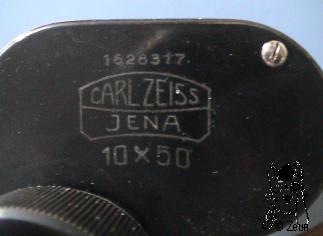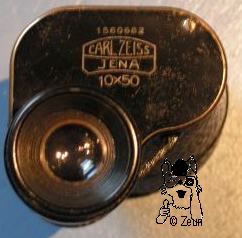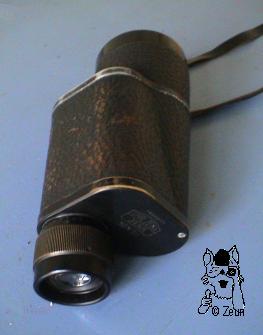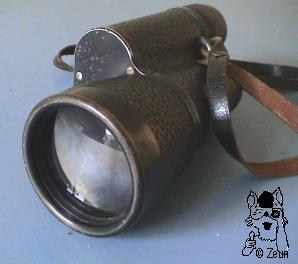Carl Zeiss Jena 10x50 Dekarismo
| Das Dekarismo von 1933 mit Seriennummer 1628317 (weiteres Modell Ser. 1560682 ca. 1931) ist vorrangig noch aus Messing gefertigt und hat eine Rauhlackummantelung (vgl. Dekarismo IQ). Die Augenmuschel ist aus Bakelit. Wie fast alle Zeiss Gläser aus der Zeit hat es ein am Gehäuse integrierte Trageöse. Die Austrittspupille ist 5mm groß und das Monokular hat ein Sehfeld von ca. 7,3°. Der Dioptrienausgleich hat eine umlaufende Skala mit markierten Werten von + bis - 10 (Fokussierung ca. 4m bis unendlich). |
The Dekarismo from 1933 with S/N 1628317 (amother model s/n 1560682 c. 1931) was still mainly made of brass. It ha s acrinkle paint armouring (cf. Dekarismo IQ). The eye-cup is made of Bakelite. As usual for Zeiss glasses of this period it has a strap lug integrated into the body. The exit pupil is 5mm, and the field of view is 7.3°. Dioptre adjustment is marked with a scale running all around the ocular and numbering of + to - 10 (focussing between 4m and infinity). |



| Das Dekarismo wiegt 598g. Die Gesamtlänge beträgt 16,2cm bis 17,5cm je nach Okulareinstellung. Der obere Deckel misst 6,3 x 6,3cm. Der Objektivtubs ist 5cm lang und hat einen Durchmesser von 6,2cm. | The dekarismo weighs 598g. Overall length is 16.2cm or 17.5cm depending on ocular adjustment. The top cover measures 6.3 x 6.3cm. The objective tue is 5cm long and 6.2cm in diameter. |


Fotos: Zeun

